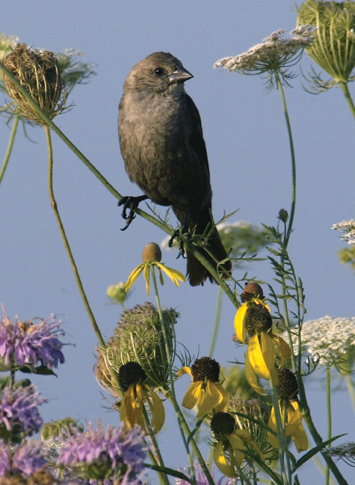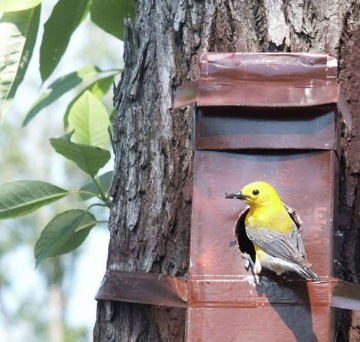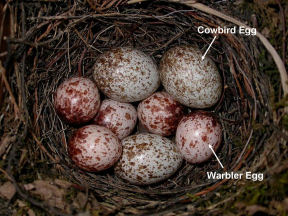Cowbirds in Illinois that sneak their eggs into other birds’ nests retaliate violently if their scam gets foiled, researchers say.



The brown-headed cowbirds of North America outsource nest building and chick raising. Female cowbirds dart into other birds’ nests, quickly lay eggs, and rush away. The nest owners are left to care for big, demanding cowbird chicks.
Why don’t the dupes throw out the odd eggs? When scientists removed cowbird eggs from warbler nests, more warbler eggs later got smashed or carried off than did eggs in nests with cowbird eggs in place. It was cowbird retaliation, conclude Jeffrey P. Hoover of the Illinois Natural History Survey in Champaign and Scott K. Robinson of the Florida Museum of Natural History in Gainesville.
That’s the first evidence of gangsterlike behavior in cowbirds, says Hoover.
A decade of monitoring prothonotary warblers in nest boxes in southern-Illinois swamps gave Hoover the idea for the new experiment. The nest boxes sit on poles coated with axle grease to thwart raccoons, snakes, and most other raiders. Egg-laying cowbirds still strike, and Hoover had for years left the cowbird eggs alone. In 2002, he and other researchers removed cowbird eggs. Nest vandalism suddenly increased.
No one saw the vandals, but Hoover and Robinson turned to an idea put forward in 1979 by Israeli biologist Amotz Zahavi. He’d suggested that by tending the weird-looking eggs and chicks, the foster parents protect their own progeny. In a rare test of the idea, cuckoos retaliated against magpies in Spain that rejected cuckoo eggs, scientists reported in 1995.
In the new experiment, the researchers recorded egg damage in only 6 percent of the warbler nests where cowbird eggs remained unmolested. In contrast, 56 percent of nests were vandalized after the researchers removed the cowbird eggs. When the scientists removed the cowbird eggs but added new fronts to the nest boxes with holes too small for cowbirds, there was no damage.
So, the nest trashers are cowbirds, Hoover and Robinson conclude in the March 13 Proceedings of the National Academy of Sciences.
When the cowbird eggs stayed in the nest, some warbler chicks starved because the pushy cowbird nestlings took so much of the food. Yet with the retaliation attacks, the nests where cowbird eggs had been removed produced, on average, only 40 percent as many warblers as the cowbird-fostering nests did, says Hoover.
“This is a surprising result,” says Stephen Rothstein of the University of California, Santa Barbara.
Rothstein hasn’t tested whether cowbirds retaliate, but he says, “My bet, before this paper, would have been definitely no.” He’s now reconsidering but says, “I’d like to see more direct evidence,” such as video.
So would Naomi Langmore of the Australian National University in Canberra. Still, she describes the evidence as “compelling.”
“Best evidence to date,” says Rebecca Kilner of the University of Cambridge in England.
Hoover and Robinson also report evidence of another cowbird trick: farming. The cowbirds lay their eggs in a host nest during the same several days that the hosts lay their eggs. The researchers noted that warbler nests that at first had escaped cowbird egg invasions had a 20 percent rate of vandalism. When these warblers rebuilt after the disaster, 85 percent of the nests got hit by cowbirds. Hoover and Robinson suggest that the cowbirds had created new egg-placing opportunities for themselves.







